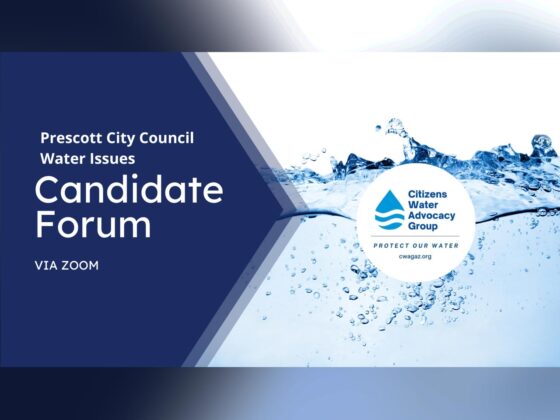By GARY BEVERLY, PH.D
Verde Valley News – Water management is one of the most important issues for governments throughout Arizona. This is especially true for the upcoming primary and general elections for Prescott City Council because our area faces long-term water shortages.
The Citizens Water Advocacy Group (CWAG) will gather the candidates together to discuss how water policies affect both citizens and the Verde River on June 24 at 10 am via Zoom. Register under “Next Event” at cwagaz.org. This will be our 19th annual Water Issues Candidate Forum and all seven candidates will participate.
The purpose of the Candidate Forum is to insert water issues into the political and electoral dialogue, to educate voters and candidates about water issues, and to inform the public about the candidates’ knowledge and positions on water issues. We have sent the discussion questions to the candidates in advance so they can prepare for what we hope will be a lively exchange.
CWAG will ask candidates their views on these important topics:
Water Conservation planning. Prescott has the best collection of water conservation measures in the Prescott Active Management Area (PrAMA), but it lacks a long-term plan to continuously improve our water efficiency. Planning works. If you don’t plan, the result is no progress.
Regional planning. Arizona water law holds the communities in the PrAMA responsible for attaining safe yield. However, instead of cooperating to reduce a growing groundwater overdraft, communities compete with one another for water to support additional growth. There is currently no regional planning to reach safe yield. The Yavapai County Board of Supervisors cancelled their Water Advisory Committee in 2014 due to unproductive bickering among communities. The Upper Verde River Watershed Protection Coalition has been unwilling and unable to tackle regional planning for 17 years. Unless the PrAMA communities work together, the aquifer will continue to decline (already, many domestic wells on the edges of the aquifer have gone dry).
Water Quality. Arsenic has been a water quality challenge for decades, but the recent discovery of PFAS, a collection of “forever chemicals” in our groundwater, has raised new questions about the safety of our municipal water. To provide drinking water, Prescott blends groundwater from high arsenic/low PFAS wells with water from low arsenic/higher PFAS wells to deliver water that barely meets the EPA’s arsenic standard and proposed PFAS standards.
Verde River. The base flow of the upper Verde River is steadily declining to alarmingly low levels, primarily due to rising temperatures in the watershed. Additionally, Prescott’s planned Big Chino pipeline project is an existential threat to the river. The pipeline is intended to support future population growth, but Prescott doesn’t need that water to achieve their growth goals. Prescott Valley desperately wants Big Chino water. Is growth a good reason to degrade the last surviving living perennial river in Arizona?
These are difficult issues. To assist candidates, CWAG has prepared a non-technical summary of the Basic Facts. Both the Basic Facts and the Forum Questions can be downloaded from cwagaz.org on the event registration page.
CWAG urges citizens to:
- REGISTER TO VOTE on or before July 3 at https://yavapaiaz.gov/electionsvr/register-to-vote .
- VOTE. Mail-in ballots will be mailed on July 5.
- ATTEND THE FORUM. Saturday, June 24, 10:00 a.m. – 12:00 p.m. via Zoom. Register under “Next Event” at cwagaz.org.
Gary Beverly is a member of the CWAG Executive Committee and a retired business owner working to protect the Verde River.





2 Comments
Well said, Gary Beverly.
Pipelines and dams have proven themselves to be ecological disasters in nearly every single instance. Many Countries including Switzerland have begun removing as many of them as is feasible and have begun implementations to reverse the damage done to their local communities.
As a youngster I used to Trout fish rivers in Colorado. I drank the water straight from the source and cleaned, cooked and ate my trout on location . I wouldn’t even consider doing so today even in a survival situation. Too many heavy metals and chemicals have contaminated our waterways.
I often wonder how many of our dried up stream and river beds in and around Sedona would be active waterways if we hadn’t damned and diverted so many waterways?
How about conserving what we have and preventing future loss and damage by halting any new water access requests.